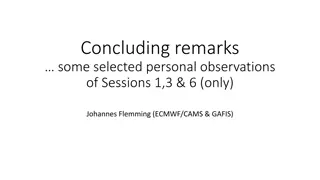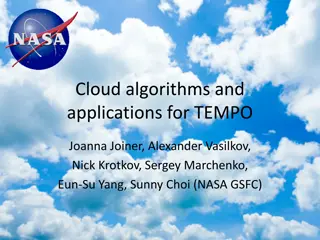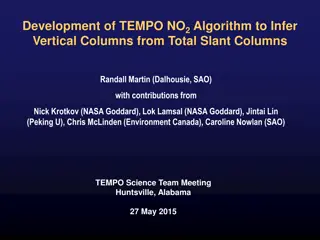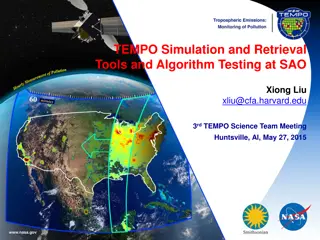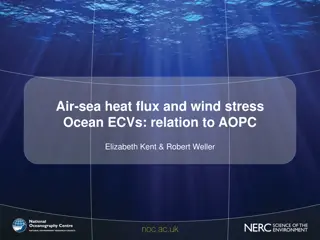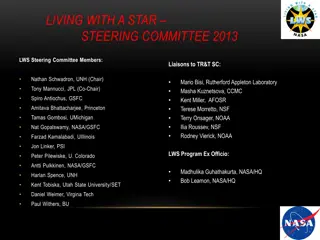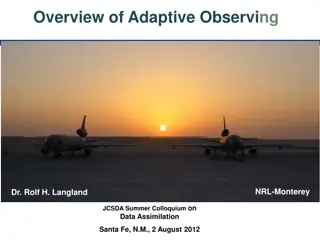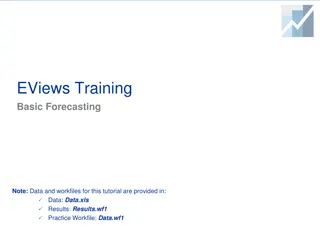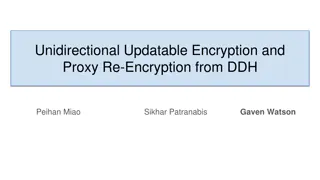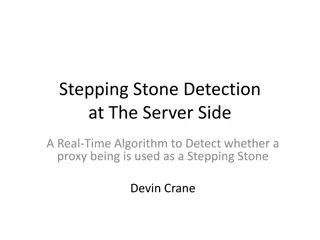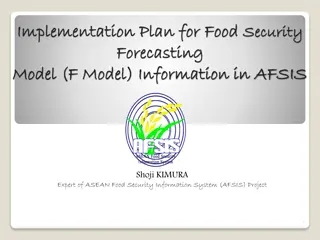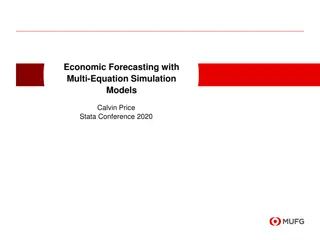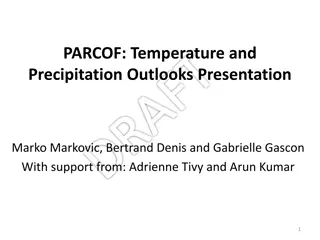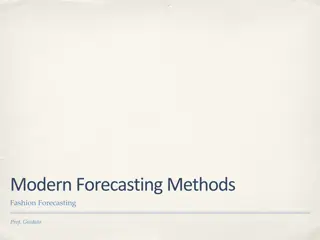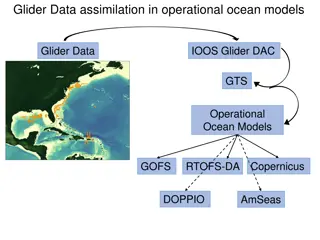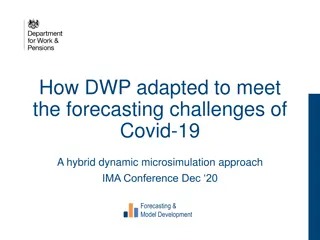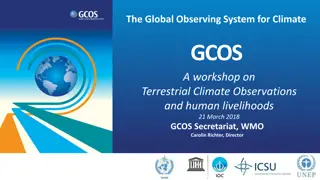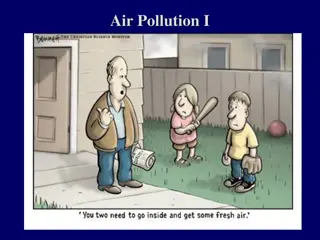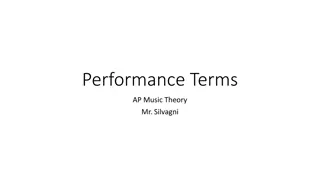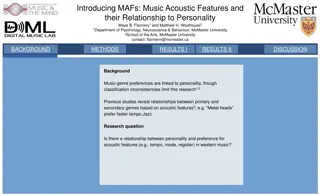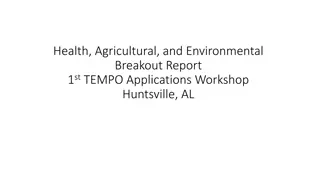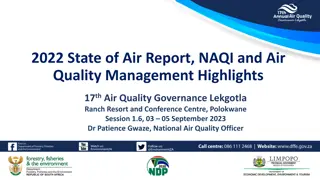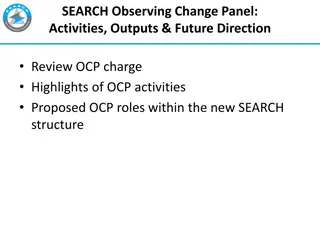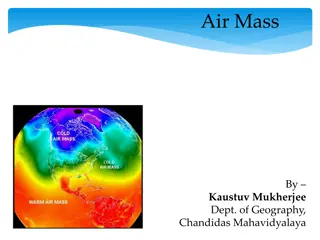Enhancing Air Quality Forecasting with TEMPO Retrievals in Proxy Observing System
Improvements in Air Quality Forecast Skill (AQFS) are explored by assimilating TEMPO retrievals in a Proxy Air Quality Observing System (AQOS) using WRF-Chem/DART. The study focuses on benefits identified through a designed OSSE scenario, including application to the Front Range Air Pollution and Photochemistry Experiment (FRAPPE), and emphasizes the use of Compact Phase Space Retrievals (CPSRs) for efficient chemical assimilation. The research showcases advancements in identifying and leveraging TEMPO AQFS benefits for enhanced air quality predictions.
Download Presentation

Please find below an Image/Link to download the presentation.
The content on the website is provided AS IS for your information and personal use only. It may not be sold, licensed, or shared on other websites without obtaining consent from the author. Download presentation by click this link. If you encounter any issues during the download, it is possible that the publisher has removed the file from their server.
E N D
Presentation Transcript
Incremental Air Quality Forecast Skill (AQFS) Improvements from Assimilating TEMPO Retrievals in a Proxy Air Quality Observing System (AQOS) with WRF-Chem/DART Arthur P. Mizzi, Matthew S. Johnson, Aaron R. Naeger1, Daven K. Henze2, and Jeffrey L. Anderson3 USRA/NASA Ames Research Center Earth Science Division (arthur.p.mizzi@nasa.gov) 1UA-Huntsville/NASA Short-Term Prediction Research and Transition Center 2UC-Boulder/Department of Mechanical Engineering 3NCAR/Computational Informational Systems Laboratory TEMPO Science Team Meeting August 2020 Dr. Arthur P. Mizzi arthur.p.mizzi@nasa.gov 1
Poster Overview (eight slides) (Continuous cycling Full cycle 90 sec.) OSSE Design for Using WRF-Chem/DART to Identify AQFS Benefits from Assimilating TEMPO retrievals with a Proxy AQOS. An Introduction to WRF-Chem/DART and Results from Application to the Front Range Air Pollution and Photochemistry Experiment (FRAPPE). An Introduction to Compact Phase Space Retrievals (CPSRs) and Application to TEMPO O3 Retrieval Profiles TEMPO Science Team Meeting August 2020 Dr. Arthur P. Mizzi arthur.p.mizzi@nasa.gov 2
An OSSE for Identifying TEMPO AQFS Benefits NASA/SPORT generates synthetic TEMPO retrieval products from a GEOS- Chem/GEOS-5 nature run. NASA/ARC-ESD runs WRF-Chem/DART with ECMWF CAM meteorology and chemistry for a regional nature run. Use the synthetic products to generate true TEMPO retrieval observations from the regional nature run. Use MOPITT, OMI/TROPOMI, MODIS, and AirNow observed data to generate the corresponding true observations from the corresponding regional nature run. Perturb the true observations using the reported error characteristics to generate the real observations. Run WRF-Chem/DART with NCAR CAM-Chem or WACCM meteorology and chemistry (with different WRF-Chem physics and chemistry option) for the assimilation experiments. CNTL EX assimilate meteorology only; NO-TEMPO EX same as CNTL EX but also assimilate MOPITT, OMI/TROPOMI, MODIS, and AirNow; TEMPO EX same as NO-TEMPO EX but also assimilate TEMPO; and xxx-ADJ EX repeat the chemical assimilation experiments with emissions adjustment. TEMPO Science Team Meeting August 2020 Dr. Arthur P. Mizzi arthur.p.mizzi@nasa.gov 3
WRF-Chem/DART and FRAPPE WRF-Chem/DART couples WRF-Chem and DART for meteorology and chemistry data assimilation with an ensemble adjustment Kalman filter. Assimilates MOPITT, IASI, MODIS, and AirNow columns, profiles and in situ measurements. Assimilation of OMI, TROPOMI, and TEMPO being added for the TEMPO OSSE. Assimilates retrieval profiles as raw retrievals (RETRs) and compact phase space retrievals (CPSRs). CPSRs result in substantial storage and computational savings. Results from applying WRF-Chem/DART to FRAPPE. These are not from the TEMPO OSSE. They demonstrate the benefits of chemical assimilation with CPSRs. TEMPO Science Team Meeting August 2020 Dr. Arthur P. Mizzi arthur.p.mizzi@nasa.gov 4
Compact Phase Space Retrievals (CPSRs) Chemical assimilation is computationally expensive. CPSRs reduce that cost by one minus the ratio of the rank to the dimension of the averaging kernel. For assimilation of MOPITT and IASI profiles that means reductions of 60% to 80% respectively. We are investigating the corresponding reductions for TEMPO. Based on Mizzi et al. (2016): The quasi optimal form of the retrieval equation is ?? ? ? ?? ??= ??? (1) where ? is singular, and its leading left singular vectors span its range. Do an SVD of ?, set the zero singular values and vectors to zero so that ? = ????= ?0?0?0 Compression Transform. ? and project (1) onto the singular vectors. This is the The compressed retrieval error covariance an SVD of ?? singular vectors. This is the Diagonalization Transform. The results is ??? 2= ?0 2?0 is still non-diagonal. Do ?? 2 so that ?? 2= ????and project the compressed form of (1) onto the ?(?? ? ? ?? ??)=??? ???. (3) ??? 1 2?0 1 2?0?0 TEMPO Science Team Meeting August 2020 Dr. Arthur P. Mizzi arthur.p.mizzi@nasa.gov 5
CPSRs Applied to TEMPO O3 Retrieval Profiles TEMPO O3 retrieval profiles (2007 GEOS-Chem run: 15th of each month, 37 east- west, 21 north-south, and 48 vertical point (9324 profiles)). Left column Reported and SVD-based DOFS histograms. These should be the same. We are investigating why they are different. Right columns Time and space mean reported averaging kernel (AK) profiles. Those profiles show the greatest sensitiv- ity in the upper part of the profile (above 15 km). They show the greatest tropospheric sensitivity in the middle and upper troposphere (between 2 km and 10 km). TEMPO Science Team Meeting August 2020 Dr. Arthur P. Mizzi arthur.p.mizzi@nasa.gov 6
Compressed and Rotated TEMPO O3 AKs Due to discrepancy between reported and SVD-based DOFS, retain sufficient modes to explain the reported DOFS. Left column compressed AKs (SV-1 leading and SV-4 trailing modes). Right column compressed and rotated AKs. Dominant mode shows sensitivity in the lower half of the troposphere (0 km and 5 km). The dominant mode near-surface sensitivity was not seen in the raw profiles. TEMPO Science Team Meeting August 2020 Dr. Arthur P. Mizzi arthur.p.mizzi@nasa.gov 7
Summary NASA/ARC-ESD is using a WRF-Chem/DART OSSE to identify the benefits of assimilating TEMPO retrievals in a proxy AQOS with CPSRs. We have developed forward operators for OMI and TROPOPMI and are currently integrating the ECMWF CAM AQ forecast into WRF-Chem/DART. Application of WRF-Chem/DART to FRAPPE shows: (i) chemical assimilation improves skill compared to no chemical assimilation; (ii) assimilation of AQ surface observations improves near-surface skill but degrades skill in middle and upper troposphere; (iii) assimilation of raw retrieval profiles improves skill compared to assimilating only AQ surface observations; and (iv) assimilation of CPSRs improves skill compared to assimilating raw retrieval profiles or AQ surface observations. Synthetic TEMPO O3 retrieval profiles have greatest sensitivity above 15 km and greatest tropospheric sensitivity between 2 km and 10 km. After the CPSRs transform, based on the reported DOFS, there are approximately four dominant modes. The leading mode has lower tropospheric sensitivity not seen in the raw profiles. . TEMPO Science Team Meeting August 2020 Dr. Arthur P. Mizzi arthur.p.mizzi@nasa.gov 8


